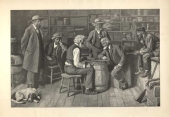The Checker Maven
The World's Most Widely Read Checkers and Draughts Publication
Bob Newell, Editor-in-Chief
Published every Saturday morning in Honolulu, Hawai`i
Noticing missing images? An explanation is here.
An Evening's Study

Study is usually a good thing; it's often an important part of the road to success in many an endeavor, checkers not the least among them. Sometimes, though, it gets a little overwhelming, and we sympathize with the poor student shown above, who seems to have gone into something like "study meltdown."
As today's entry in our Checker School series, we present a problem that the great checker writer Ben Boland called An Evening's Study. We suspect that there's enough material here for much more than a single evening, and we advise you to avoid the fate of our hapless student. Take your time and enjoy rather than trying to cram it all in at once.
BLACK

WHITE
White to Play and Win
W:W22,21,12,K7:BK23,13,9,5.
Will you be an "A" student on this one, or will your grade be somewhat lower? It's up to you; put in your study time and then click on Read More to see the solution, sample games, and detailed study notes.![]()
The Jaques Shot
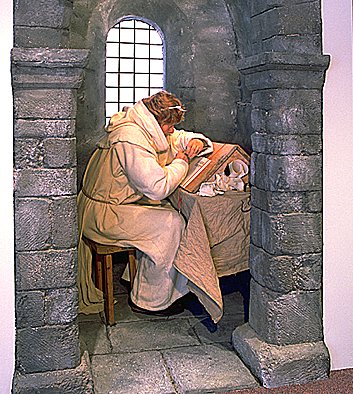
We've all heard the well-known French children's song Frere Jaques, but we'll guess that relatively few of us are familiar with its origins and possible meanings. Frere Jaques is usually translated as "Brother John," but "brother" can refer to a monk as well as a sibling. In fact, there's some evidence that Frere Jaques is related to Girolamo Frescobaldi's Fra Jacopino, lending credence to the "monk" theory.
We don't think Fra Jacopino, or Frere Jaques for that matter, were checker players, though perhaps they knew of an older version of the game. In any case, the subject of today's column, a different Jaques, was certainly a checkerist. Willie Ryan, in his seminal work Tricks Traps & Shots of the Checkerboard, gives us the scoop.
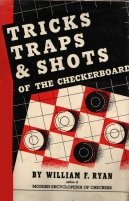
"One of the prettiest of all strokes is the much heralded Jacques Shot. E. Jacques, of Canada, used it for the first time in defeating a player by the name of Campbell, first name unknown. Invariably, writers have used the order of moves played in the Campbell-Jacques game to illustrate the stroke, but as explained in my note B, this invalidates the scientific value of the coup. It is neither practical nor advisable to make a losing move to bait a trap. Any experienced player knows better than to take such a risk. In my treatment of the Jacques stroke, the correct order of moves is given so that white can play for the shot without making a losing move at any point.
| 9-13 | 11-16 | 13-17 |
| 24-19 | 25-21 | 31-26---3 |
| 11-16 | 6-9 | 9-13---4 |
| 22-18 | 23-18 | 25-22 |
| 8-11 | 16-23 | 12-16 |
| 28-24 | 26-19 | 15-10 |
| 16-20 | 4-8---A | 2-7---C. |
| 18-14 | 29-25 | Now see the |
| 10-17 | 7-11---B | diagram. |
| 21-14 | 19-15 |
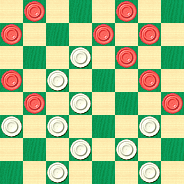
WHITE
White to Play and Win
W:W32,30,27,26,24,22,21,18,14,10:B20,17,16,13,11,8,7,5,3,1.
A---The following is much stronger---1, and almost makes the run-up on the Jacques Shot untenable: 13-17, 18-15* (the only move to draw), 9-18, 21-14, 18-22, 30-25*, 7-10, 14-7*, 2-18, 27-23*, 18-27 (20-27, 23-14, 22-26, 32-23, 26-30, 25-21, 1-6, 23-18, a draw), 25-18, 5-9, 32-23, 20-27, 31-24, 9-13, 19-15, 13-17, 18-14, 17-22, 14-10, 22-26, 23-19, 4-8, 24-20*, 26-31, 20-16, 31-27, 29-25*, 27-24 (27-23, 25-22*, 23-27, 10-6*, a draw), 16-11, 24-20, 11-4, 20-16, 4-8, 16-23, 15-11, 12-16, 8-12, etc.; a draw. Wm. F. Ryan.
B---If 8-11 is played here, then white's only move to draw is 25-22*---2. In the historical Campbell-Jacques game, 13-17 was played; white (Jacques) replied with 31-26, which loses for black by: 8-11, 32-28 (25-22, 11-15, black wins), 17-22, 26-17, 11-15, 19-10, 9-13, 25-22, 5-9, 14-5, 7-32, 24-19, 32-27, etc. F. F. Smith, Birmingham, England. However, if after 13-17 at B, white replies with: 18-15, 9-18, 21-14, a draw by black will be difficult. Hence, to reach the Jacques Shot scientifically without either side making a losing move, 7-11 must be played before 13-17, as the latter move virtually loses at this point.
C---The losing move, and it forms the great Jacques Stroke. Although this classical 12-piece clearance has been essayed and acclaimed by 1001 writers on the game, not one has ever attempted to show black's losing move, nor has any authority ever published the play leading up to the shot in the proper scientific sequence. This is not unlike a musician with rheumatic fingers trying to do justice to a fine rhapsody on a rusty instrument that is out of tune. My examination of the situation shows that instead of 2-7 at C, black can effect the following beautiful draw, two pieces short: 16-19*!, 24-15, 2-7*, 27-24, 20-27, 32-23, 5-9, 14-5, 7-14, 18-9, 11-27, 21-14, 3-7*!, 26-23, 27-31, 23-19, 13-17*!, 22-13, 8-11, 30-25, 31-27, 25-21, 27-23, 21-17, 23-16, 9-6, 1-10, 5-1, 16-12, 13-9, 10-15, 1-6, 11-16. Wm. F. Ryan. This draw is almost as good as the shot!"
1---The computer doesn't see any real difference between the two moves---Ed.
2---The computer gives 32-28 to draw and sees 25-22 as a possible White loss---Ed.
3---A probable loss for White; 30-26 was required here. We're a little surprised Willie missed this---Ed.
4---But Black gives away all the advantage. 11-16 likely would have won---Ed.
You don't need to be a monk, speak French or Italian, or be familiar with musical history to solve the problem diagrammed above. You do need to be a pretty good checker player, though. When you've found la solution (or should that be la soluzione?) click your mouse on Read More to check your work.![]()
Marvin Opens the Season
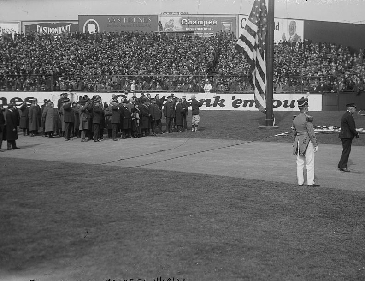
It was the opening day of the summer season. Marvin J. Mavin, captain of the National Checker League's Detroit Doublejumpers, had lead his team to a second-place finish in the winter season, and was hoping to go all the way this time. The opener was taking place on the road, with the Doublejumpers facing the Pittsburgh Paisleys in the first game of a four-game series.

Marvin J. Mavin
Marvin learned a hard lesson during his exile to the minor leagues (see previous Checker Maven column), and had laid off the beer during the playing season. Unfortunately, his girlfriend Priscilla had been away on business in Turkmenistan during the inter-season break, and absent her watchful eye Marvin had backslid--- more than a little.
In short, Marvin wasn't quite in the best condition for today's match. And he had to face the Paisleys' top player, Karl "the Mauler" Mortenson. The two sat facing each other over the board in the center of the huge stadium, which was packed with fervent checker fans eager for the start of the new season. The National Anthem was played and the players took their seats. Marvin and Karl shook hands. Karl gave Marvin his signature "Pittsburgh Can Crusher" handshake, and it was all Marvin could do not to howl with pain. "Hey, man, that's the hand I move the pieces with," he said, "lay off a little." But Karl just grinned and said something about sissies and wusses.
But then, accompanied by a great cheer from the crowd, the match began.

Karl "the Mauler" Mortenson
Black: Karl Mortenson
White: Marvin J. Mavin
| 1. | 9-14 | 22-18 |
| 2. | 5-9 | 24-19 |
| 3. | 11-15 | 18x11 |
| 4. | 8x24 | 28x19 |
| 5. | 4-8 | 25-22 |
| 6. | 8-11 | 22-18 |
| 7. | 11-16 | 29-25 |
| 8. | 7-11 | 25-22 |
| 9. | 10-15 | 19x10 |
| 10. | 6x15 | 27-24 |
| 11. | 16-20 | 23-19 |
| 12. | 20x27 |
"Big bad dude doesn't know book play," Marvin muttered. Indeed, while the text move is fine, 14-23 is usual. "Yeah, well I know a few new tricks, wussie," Karl growled back.
| 12. | ... | 19x10 |
| 13. | 14x23 | 26x19 |
| 14. | 9-13 | 31x24 |
| 15. | 2-7 | 30-26 |
| 16. | 7x14 | 26-23 |
| 17. | 3-7 | 24-20 |
| 18. | 7-10 | 32-28 |
Marvin was sweating, and his head was pounding; he was regretting the excesses of the past week. If he lost today, Priscilla would instantly realize that he had gone off the wagon, and when she returned home she would show him no mercy.
| 19. | 1-5 | 22-18 |
| 20. | 5-9 | 28-24 |
| 21. | 13-17 |
"Take that, you wimp," Karl said. "You're dead meat, little boy."
Marvin knew he was in tough straits. Every move on the board seemed to lose two men. He had to pull out a draw, not only to save the game, but to save his hide. Karl thought he was some kind of tough guy, but Marvin knew that you haven't seen tough until you've been on the wrong side of Priscilla.
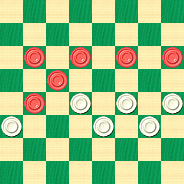
WHITE
White to Play and Draw
W:W24,23,21,20,19,18:B17,14,12,11,10,9.
Can you find the draw here, or would you too face the equivalent of Priscilla's wrath? All we can say is that we think it might be best to solve the problem! Find the draw and then click on Read More to see the solution and the rest of our story.![]()
2nd Edition of "How to Win at Checkers"

A revised and corrected 2nd edition of Fred Reinfeld's How to Win at Checkers is now available here or from the link on the right side of the page. The revised edition fixes a quirk in the rendering of the board diagrams and includes detailed errata graciously provided by Mr. George Hay. We hope you both enjoy and benefit from Mr. Reinfeld's classic work.
A Grand Rapids Speedster

Today's problem has quite a history. It's credited to an American, a Mr. O. H. Richmond of Grand Rapids, Michigan, but it was actually published in Glasgow, Scotland, some time in the 1880s. Grand Rapids in the 1880s was a town of less than 60,000, mostly known for its production of fine furniture. In the world of checkers as well, it apparently had international reach.
And now, something like 125 years later, we too can enjoy this excellent problem. We're presenting it as a speed problem (what else would we do with a problem from Grand "Rapids"), but we must say that it pushes the limit for speed solving. For this reason, we'll allow 30 seconds for the solution. Our guess is that you'll either see it right away, or you won't. We rate the problem as medium to hard in difficulty; medium if you take your time, and hard if you try to stay within the 30 second time limit.
When you're ready, click on the link below to show the problem and start the clock. When you're finished, come back and click on Read More to see the startling solution.
June Speed Problem (medium to hard, 30 seconds)
![]()
Subtle

An image such as the one above, unusual though it may seem, is filled with deep and and often subtle symbolism and meaning, unraveled only through careful consideration and study.
Today's entry in our Checker School series demonstrates once more that checkers too can be deep and subtle, with each move having its own meaning and significance. The problem shown below, first published over 140 years ago, is definitely not easy, but by any measure it is rewarding, satisfying, and entertaining, and we might even say, enlightening.
BLACK

WHITE
White to Play and Draw
W:W28,17,13,K7:BK23,20,6,5.
Can you unravel the subtleties of this difficult position? Think deeply, and be careful of seemingly small nuances that loom large in the end. When you've unraveled the meaning of the problem, click on Read More to see the solution, sample games, and detailed explanatory notes.![]()
Checker Apps for Android

A few weeks back, we presented Ed Gilbert's review of checker apps for the iPhone. We promised a similar review of Android apps, and we're bringing you that review today.
The iPhone scene was frankly pretty bleak. Ed didn't find a single truly serious checker app for the popular Apple smartphone. We'll cut to the chase: for Android phones, the situation is somewhat better. There are two reasonable candidates for the "serious app" title and a whole host of "toy" apps.
As was the case with the iPhone, there is just too much detail for a single weekly column, so instead you'll find the full details on this separate web page.
The two apps that we think merit consideration are Checkers Tutor, by world class checker programmer Martin Fierz (author of CheckerBoard and the Cake computer engine), and Checkers for Android by programmer Aart Bik, who is best known for Chess for Android. Aart's checker app is free and Martin's app sells for just one dollar.


Martin Fierz and Aart Bik
Interesting and detailed email interviews with both Martin and Aart can be found on the web page linked above.

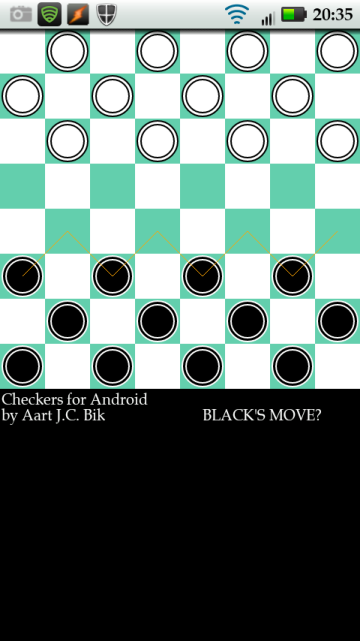
So, which app should you install? Checkers Tutor plays a reasonable game, certainly well above the casual skill level. The same can be said of Checkers for Android. It's also safe to say that neither of these will provide a serious challenge to a master-level player.
Our usual benchmark is Martin Fierz's Simple Checkers engine. Both Checkers Tutor and Checkers for Android play somewhat better than Simple, at least based on the limited trial matchups conducted in our offices. But you won't get play at the level of Cake or KingsRow, either.
There's some irony here. Both Martin and Aart received a lot of user feedback saying that the engines are too strong and that the user can never win a game! This perhaps says more about the casual player than it does about the strength of the computer engines.
How do Checkers Tutor (CT) and Checkers for Android (CFA) compare with each other?
CT has hands-down the better graphics and display, and some additional play features, such as move take-back and replay, neither of which are present in CFA. Both programs lack a move list or a means of exporting moves. CT has optional square numbers; CFA allows compulsory jumping to be turned off, which you may consider a feature or an anti-feature, but Aart says users demanded it. CT allows for selection of a random 3-move ballot. CFA has a tiny endgame database which most notably will allow it to convert a two kings vs. one win, something a surprising number of programs can't do.
Neither app allows for position set-up, but neither engine is really strong enough to do meaningful analysis.
Which engine plays better checkers? That's a good question. We think CT has a definite edge, albeit not a large one. In the two head-to-head matches that we conducted, CT handily won one of them. CFA got a winning position in the other game but then couldn't figure out the ending and the result was a draw. Such limited testing is hardly decisive, of course.
Our bottom line is that there's little reason not to install both apps and make your own comparison. It will only cost you a dollar, after all, and you'll have a lot of fun ahead of you.
Several of the test games are on the companion page mentioned earlier. What we'll show you here is an excerpt from one of the games between CT and CFA. We'll stop at one of the game's critical points and let you take over.
The game was played on April 18, 2012 at the Hawai`i State Library. Checkers Tutor had Black and played at 15 seconds per move. Checkers for Android had White and played at 10 seconds per move (it wasn't possible to set the same timing for both).
| 1. | 11-15 | 23-19 |
| 2. | 8-11 | 26-23 |
An inferior move; 22-17 or 22-28 are better.
| 3. | 9-14 |
4-8 holds the edge.
| 3. | ... | 22-18 |
A checker subtlety: 22-17 equalizes, while this does not.
| 4. | 15x22 | 25x9 |
| 5. | 5x14 | 29-25 |
| 6. | 11-15 |
4-8 would have maintained the lead.
| 6. | ... | 25-22 |
| 7. | 14-18 | 23x14 |
| 8. | 10x26 | 19x10 |
| 9. | 6x15 | 31x22 |
| 10. | 4-8 | 27-23 |
| 11. | 2-6 | 21-17 |
| 12. | 7-10 | 23-18 |
| 13. | 8-11 | 17-13 |
This move loses; 30-26 is correct. CT now has a win on the board but won't find it. Will you?
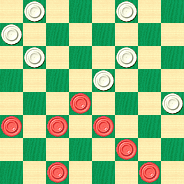
BLACK (CT)
Black to Play and Win
B:W32,30,28,24,22,18,13:B15,12,11,10,6,3,1.
Who's better, CT, CFA, or you? Match wits with the computer, then click on Read More to see the solution.![]()
The Great Lewis Stroke

Golfer Stacy Lewis is executing quite a powerful and accurate stroke in the photo above, something that takes skill, strength, and timing.
Today's excerpt from Willie Ryan's Tricks, Traps & Shots of the Checkerboard brings us a similar example from the game of checkers. Attributed to the late Lawrence Lewis, skill, strength, and timing are all part of the picture here too. Now, we doubt that checkerist Lewis and golfer Lewis are in any way related, but we don't know if golfer Lewis plays checkers or for that matter if checkerist Lewis played golf. What we do know is that you'll certainly enjoy today's problem. Let's let Willie tell us more.

| 9-13 | 15-18---A | 13-17 |
| 22-17 | 29-25---B, 1 | 19-15 |
| 13-22 | 6-9 | 1-6 |
| 25-18 | 24-19 | 24-20---2 |
| 10-15 | 9-13 | 12-16---E |
| 18-14 | 28-24 | Now look at the |
| diagram. |
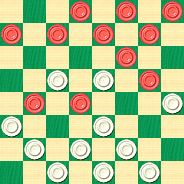
WHITE
White to Play and Win
W:W14,15,20,21,23,25,26,27,30,31,32:B2,3,4,5,6,7,8,11,16,17,18.
"White now sweeps the board with one of the best concealed strokes recorded in checker literature. It was first shown by the late Lawrence M. Lewis of Wheeling, West Virginia, who sprang it on me in a match at Flint, Michigan, in 1928, throwing the gallery of spectators into an uproar!
A---Tescheleit's Master Play says this move 'leads to a critical draw for black.' The figures featured in this study should disperse that claim.
B---Very weak, as it permits black to work in 6-9, tying up white's single corner development. Tescheleit prescribes 21-17 as the potent element in white's formation, but black has an equal game against it, as follows: 21-17, 11-15*---C, 29-25, 8-11, 17-13, 11-16*---D, 24-20 (if white adopts 24-19, 15-24, 28-19, then 6-10* puts black on the right track), 16-19, 23-16, 12-19, 27-23, 18-27, 32-16, 15-19* (a one-move redeemer), 16-11 (31-27, 4-8, 27-24, 8-12, 24-15, 12-19, 15-11, 7-16, 20-11, 6-9, ends in a draw), 7-16, 20-11, 3-7, 31-27, 7-16, and white has nothing to play for but a draw.
C---Given to lose by Tescheleit, but it is probably the only move to draw! Tescheleit shows 11-16 to draw, then 29-25, 16-20, 26-22, 12-16, 22-15, 7-10, 14-7, 3-26, 30-23, 5-9; now, instead of 17-14 as given in Master Play, 25-22, 8-12, 23-18. Now black hasn't a leg to stand on, and white wins.
D---Corrects and improves Tescheleit's Master Play, where 4-8 is played, white winning with: 25-21, 6-10, 23-19, 10-17, 21-14, etc. Recommended move seems to promote the draw without any real difficulty, indicating that the 15-18 move at A is no lame duck when properly managed in the structural stage.
E---Fatal. The guileless player would never suspect that a paralyzing coup was in the offing. Neither did I! The correct moves to a draw here are: 6-9, 26-22*, 17-26, 31-22, 12-16---F, 30-26*, 9-13---G, 15-10*, 11-15, 20-11, 7-16, 10-6*, 2-9, 14-10, 9-14, 10-6, 8-12---3, 6-2, 16-20, 2-6, 3-8 (if 12-16 is moved, the shot by 21-17 gains the draw), 6-10, 8-11, 10-19, 11-16, 22-15, 14-18, 23-14, 16-30, 14-10. Wm. F. Ryan.
F---If 9-13 is played, then follow with 23-19 for an easy draw; if 2-6 is played, then 14-10, 7-14, 22-17 will win.
G---Or 16-19, 23-16, 8-12, 15-8, 12-19, 22-15, 4-18, 14-10, 7-14, 27-23, 18-27, 32-16, 14-17, 21-14, 9-18, 16-11, 5-9, 20-16, 9-13, 25-21. Wm. F.Ryan."
1---24-19 was certainly better, though the computer doesn't agree that White has more than a small advantage---Ed.
2---Very poor, probably losing for White; 23-19 would have maintained the balance---Ed.
3---This gives up the Black advantage. Willie missed this Black win: 8-11 6-2 16-20 32-28 4-8 2-6 8-12 6-10 3-8 10x17 12-16 23x14 15-18 22x15 13x29 15-10 8-12 21-17 29-25 17-13 25-30 26-22 16-19 10-6 11-16 and now white has no defense against the coming 19-24. Black Wins---Ed.
You'll have to uncover some pretty spectacular moves to solve this one, but take a swing at it and try to drive to the solution. When you're done, click your mouse on Read More to see strength, power, and timing in action.![]()
The Big Dipper

You'll know why we chose the name "Big Dipper" for today's speed problem when you see the diagram, and you won't have much trouble with it, as it's one of the easiest speed problems we've published in quite some time. In fact, it's easy enough that we had planned to only give you five seconds to solve it, but hey, we're generous, and we went with a full ten seconds instead!
Click on the link below to show the problem and start the timer. When you're done, come back and click on Read More to see the solution.
May Speed Problem (Very easy; 10 seconds)
![]()
The Four Kings: Kings At Play
A Special Mid-Week Checker Maven Edition
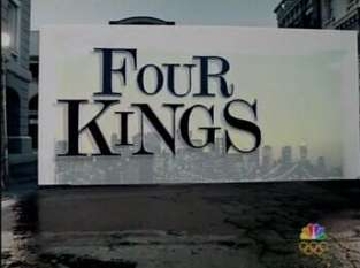
Four Kings was a 2006 television program shown on the NBC network. It apparently didn't attract enough viewers and was cancelled after just seven airings.
Mr. Bill Salot, whose work and efforts were featured in a recent Checker Maven column, has a different take on the idea of Four Kings, and Mr. Salot's checker conception is the kind of happy success that television couldn't manage. His fourth problem composition contest, bigger and better than ever, is titled Kings at Play, as each problem has at least Four Kings on the board.
We're presenting the problems below just to give you an idea of how the competitions have grown and thrived, but we won't give you the solutions; those are found on the Contest Page. While you're there, be sure to cast your vote for the problem you like best. Polls close on Sunday, May 27, 2012.
BLACK

WHITE
White to Play and Win
W:WK4,7,10,11,K17,18,19,20,22,30:B1,8,9,K12,K14,15,21,23,24,K26.
April Fools
BLACK
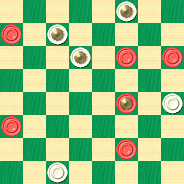
WHITE
White to Play and Win
W:WK3,K6,K10,20,30:B5,11,12,K19,21,27.
Escaped Prisoner
BLACK
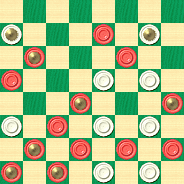
WHITE
White to Play and Win
W:WK5,K8,15,16,21,23,24,31,32:B7,K9,11,13,K18,K20,22,K25,26,27,28,K29,K30.
Multiple Choices
BLACK
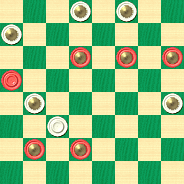
WHITE
White to Play and Win
W:WK2,K3,K5,K17,K20,22:BK10,K11,K12,13,K25,K26.
Zonk
BLACK
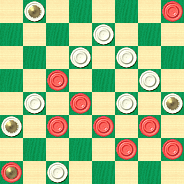
WHITE
Black to Play, White to Win
B:WK1,7,10,11,16,17,19,K20,K21,30:B4,14,18,22,23,24,27,28,K29.
Mr. Salot also tells us "... please enter your original, unpublished, dual-free problems in future contests by sending them at any time to Bill Salot, 1006 Elmwood Drive, Colonial Heights, VA 23834-2905, or wjsalot@comcast.net. Try your hand at any size or style, corrections of published play, game positions, sight solvers, stingers, strokes, novelties, strategies, whatever strikes your fancy."
The Checker Maven is both proud and delighted to support Mr. Salot's efforts.![]()
The Checker Maven is produced at editorial offices in Honolulu, Hawai`i, as a completely non-commercial public service from which no profit is obtained or sought. Original material is Copyright © 2004-2025 Avi Gobbler Publishing. Other material is public domain, as attributed, or licensed under Creative Commons. Information presented on this site is offered as-is, at no cost, and bears no express or implied warranty as to accuracy or usability. You agree that you use such information entirely at your own risk. No liabilities of any kind under any legal theory whatsoever are accepted. The Checker Maven is dedicated to the memory of Mr. Bob Newell, Sr.

